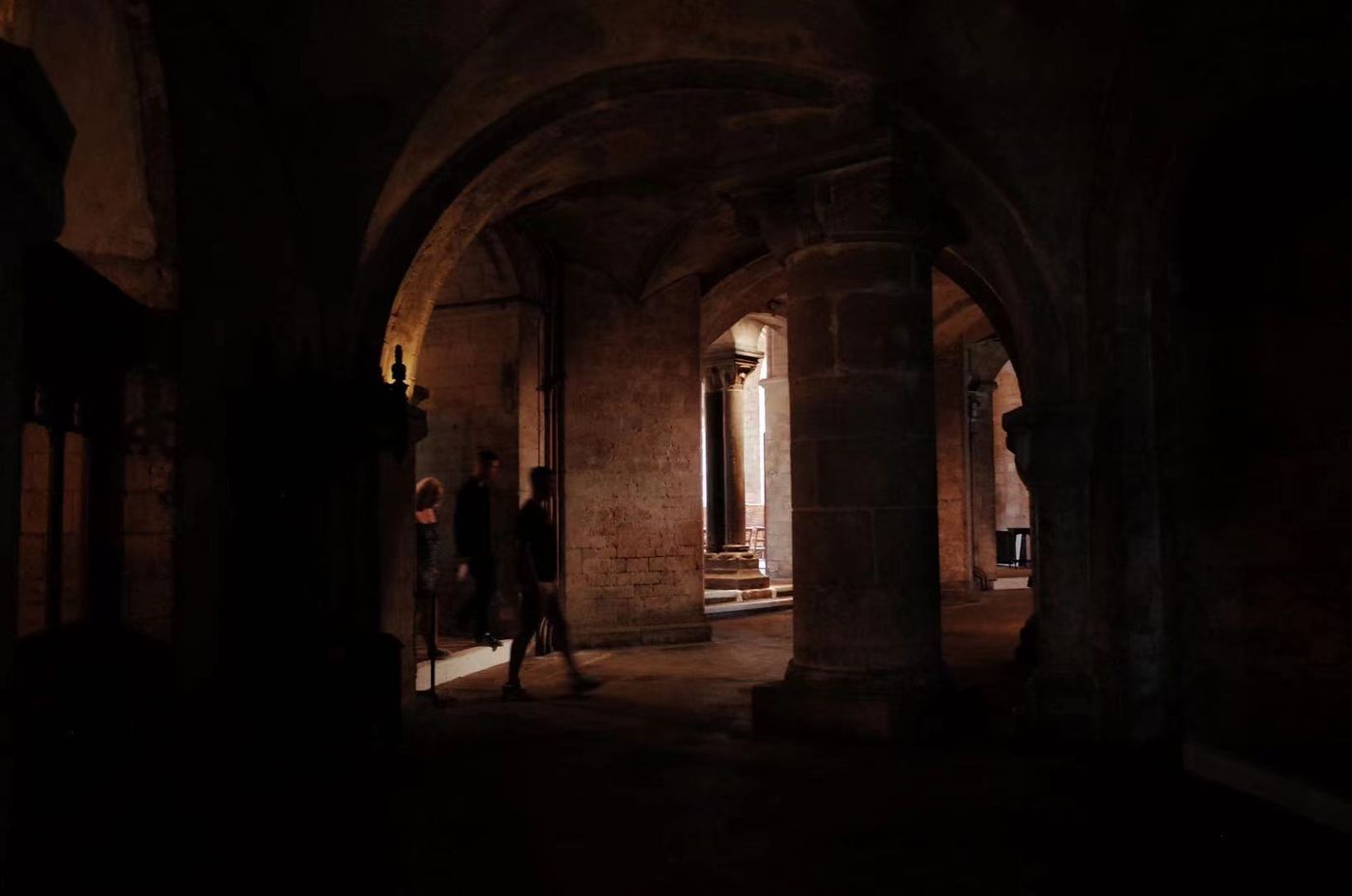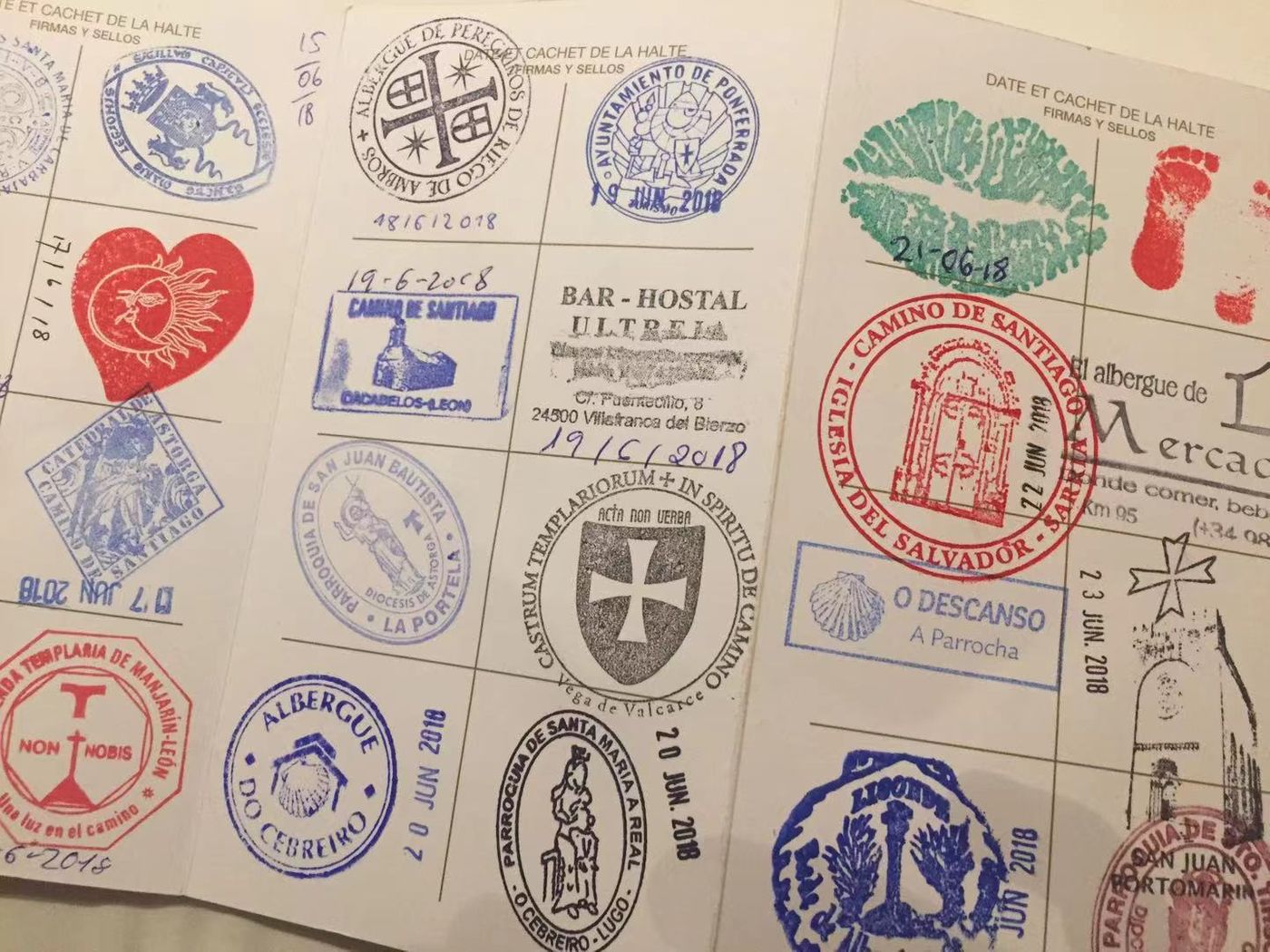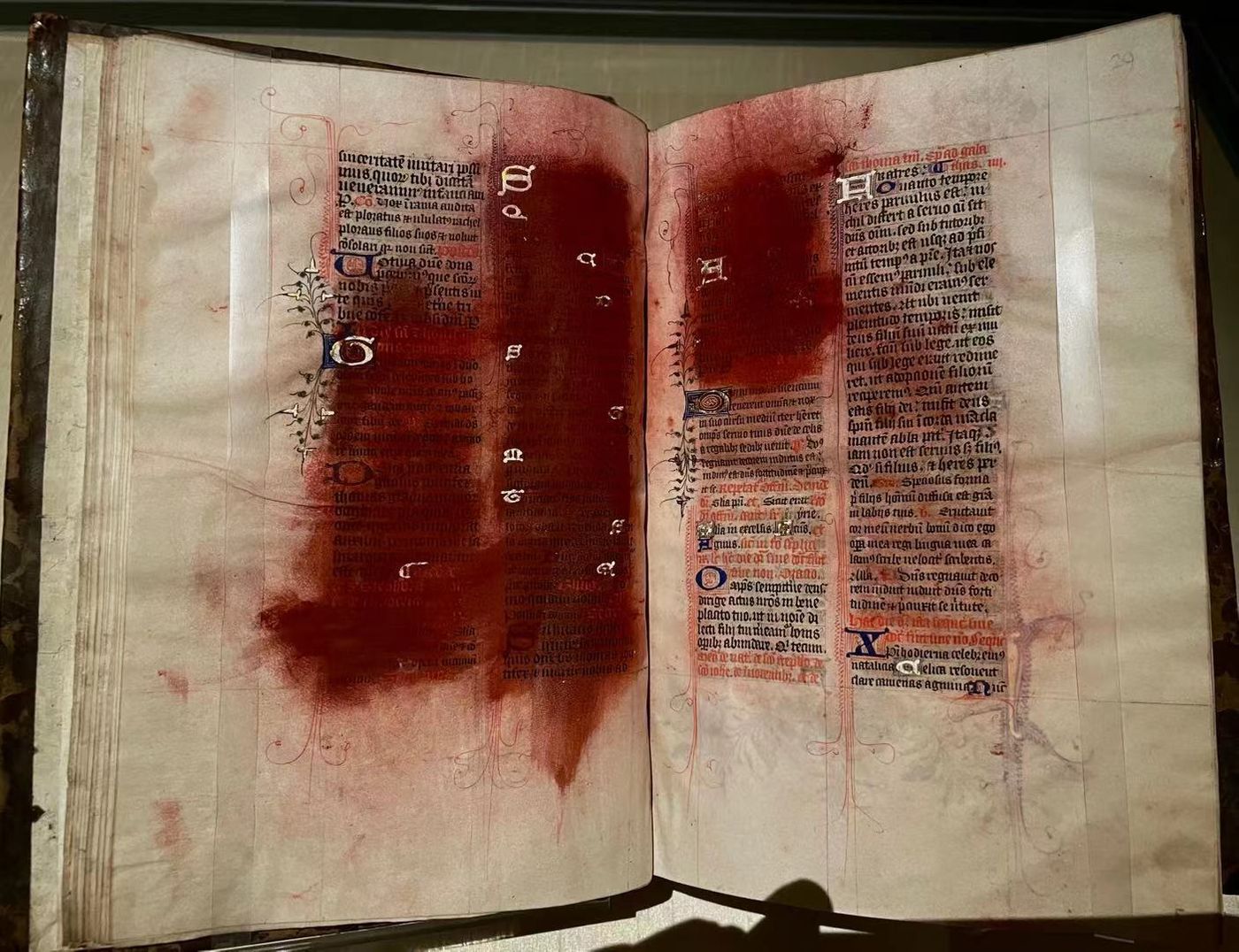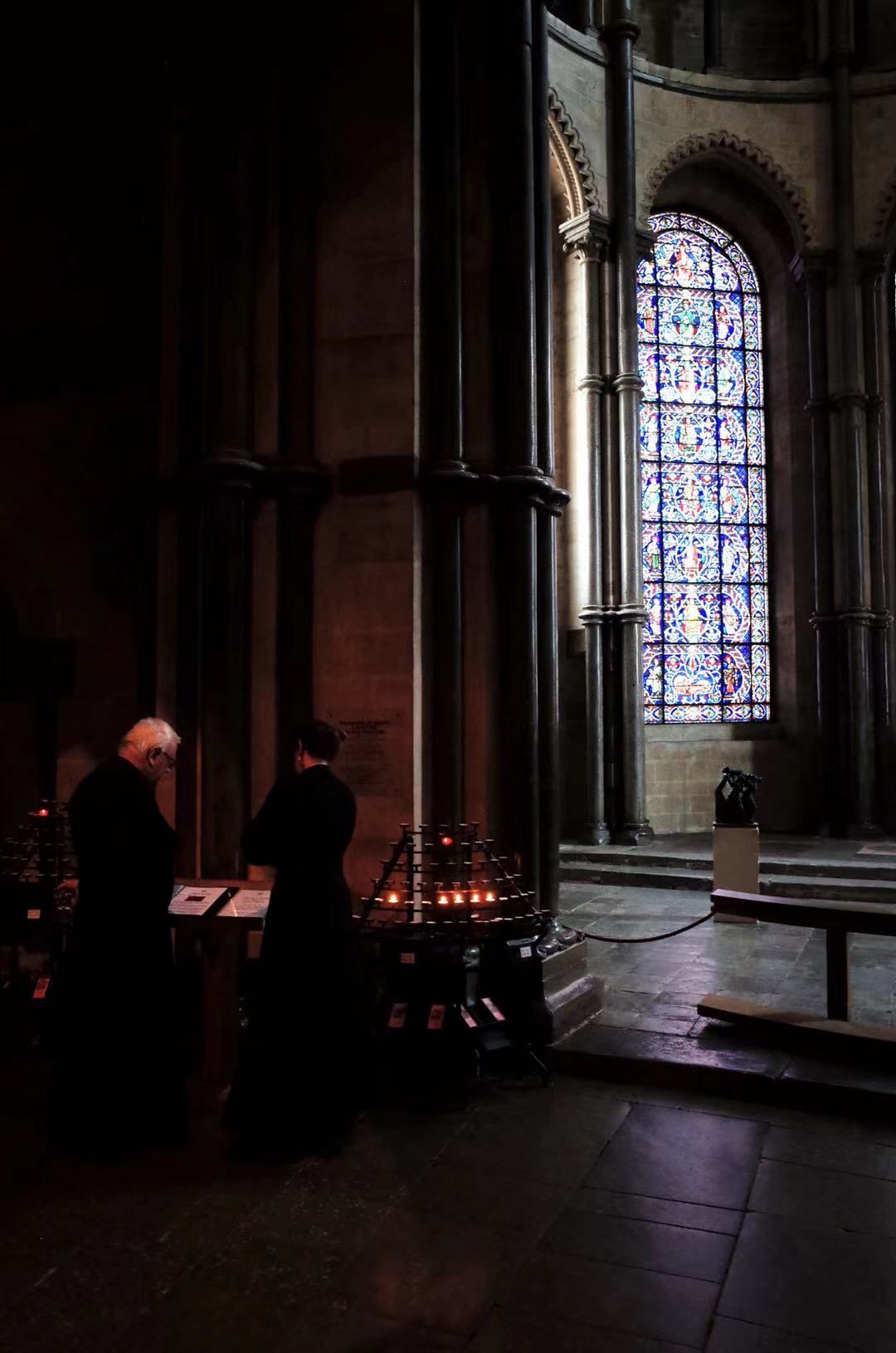Canterbury Cathedral
- Hall of Fame
- Thomas Becket
- stained glass windows
1. Palace
For our first trip, Tianyi and I chose Canterbury Cathedral.
Entering the cathedral, the texture of the columns immediately pulls the line of sight upwards, all the way to the top. Thanks to the design of the lines, the whole building looks extraordinarily tall. When the focus is on the dome, it brings attention to the details of the church. There are no murals here, but several "skeletons" that are regularly laid out where everything is enough to unfold. Sliding along the dome to both sides, the stained glass windows are lined up leaf by leaf like bamboo slips on the high wall, and down the wall, marble monuments and busts of different sizes and shapes are mottled where you can look at the nave. The chairs are made of wood, and the extension direction of the wooden strips echoes the uprights, redrawing the sight slightly upwards, passing the steps where the choir stands and the dark wood seats, and reaching the three o’clock line of the apse, where the elders’ altars are placed with instruments, the holy The ascension of the Archbishop of Augustinian Stone, the flickering candles are a sign that the Thomas Becket altar once existed. There is no need to spend more time on exquisite carvings, detailed decorations, and elegant layouts. Just take two seconds to search the Internet, and there will be a lot of photos to watch, but the soft atmosphere is more worth recording: Afternoon The sun shines through the stained windows, the brightness and temperature are suitable, there is no gloomy medieval palace, and the gray-yellow tone makes people think of the houses that can be seen everywhere in London. The church is still alive.

Going out of the nave through the north gate, you will arrive at the corridor. The pillars enclose a square green space in the middle. There are a few sarcophagi and monuments scattered on the green space. Walk inside. The sense of space created by the colonnade is completely different from that in the hall. Here, we are on the boundary between the inside and the outside. We are under the shelter of the building, and we are about to enter the open space outside the building, walking through the nave. Come on, you can breathe a sigh of relief here. Walking along the cloister, we will first reach the chapel, an empty building with dense geometric patterns on the roof that attracts us. There is also a small opening on the left side of the main entrance of the chapel, which is a light source that leads us to the other end, where the monk's quarters, the medical room and the herbal garden have long been abandoned. We sat down on the chairs in the herbal garden, with a few solitary pillar foundations standing in front of us, half-covered by flowers and plants, and a crumbling stone wall on the side, but the luster of the cut surfaces of the stones never dimmed. Compared with the buildings on the way here, it is "broken", but this "broken" seems to be intentional, leaving this relic to record the life of the monastery, or let people wandering in the hall adjust here. Body and mind, in this way, the original functions of the medical room and the herbal garden seem to have been preserved.
The hall is condensed with time, and it is not surprising to feel small when walking and watching here: after all, life is short, and compared with centuries of construction period and various art forms, what one person can do is really too limited. As a result, a sense of awe arises spontaneously, not only for a particular belief and devotion to belief, but also for every pair of hands that have contributed to it. To create the divine from the mundane, and from the finite to the infinite, this is what I find fascinating about religion, because it unites originally contradictory qualities in an attempt to achieve a certain balance: the tragic situation of people who are revealed by their beliefs, perhaps their vulnerability The source of feeling, and the spiritual support found in depression may make people brave and strong; faith gives people an opportunity to reflect quietly, but it can also easily ignite people's madness...

At this time, the pipe organ rang. The children walking in front held crosses and candles. Several monks who had just met were dressed in white dresses and looked solemn. The choir in purple robes followed closely. After all the staff were in place, the participants were seated, and the evening prayer officially began. . The presiding pastor gave a speech and welcomed everyone to this evening prayer. The words "The holy year of Santiago de Compostela" and "special day" suddenly appeared in his mouth that did not seem to open. My mind was seized. The various voices of the choir are intertwined in my ears, and the female monk recites excerpts from the Old Testament softly. My eyes follow the ritual process instructed in the manual, paragraph after paragraph, but what I remember in my heart is the clue revealed by the presiding priest. There is also the holy city of Santiago in Spain across the sea.
It turned out that this year is the holy year of the pilgrimage route of Santiago. If St. James commemorates the sunset on a Sunday, this year is a holy year, and today, July 25, is exactly the "special" that determines the holy year. day”, so the presiding pastor made a special explanation. I've done the Road to San Diego, and pedestrians on the road just call it Camino, which means "road" in Spanish. The "Road to France", which starts from the northern slope of the Pyrenees, has a long history. There are mountains, rivers, and so-called "deserts" along the road, which is nearly 800 kilometers long. There are large and small towns and churches dotted everywhere. absolutely. Those who are familiar with me will know the feeling and inspiration this road brings me. It allows me to know the physical boundaries of my continuous walking throughout the day, and it also allows me to know how people with different motives meet and meet each other, and it also allows me to experience the daily life. Religion in life. It is because of this experience that the sporadic vocabulary of the presiding pastor managed to catch me. Canterbury Cathedral was also a pilgrimage destination in history, and it is still regarded as one of the spiritual centers of England, and even the entire Anglican Church, and has a status corresponding to the Cathedral of Santiago. It is not difficult to understand the mention and blessing of Santiago, and it also adds to the spirit of the universal church. So, in the halls of Canterbury, I seemed to see a scene that is unique to Santiago: pilgrims with pilgrims on their backs and sticks sat and stood, the mud on shoes and the sweat on the front of the clothes filled the church to the fullest, Bishop. The nationality and number of today's pilgrims were announced in the center of the church, after which several priests worked together to raise and shake a large silver censer. The superposition of Canterbury and Santiago is wonderful. A familiar scene is embedded in an unfamiliar space. Although the history and style of the two churches are completely different, coupled with the changes in the current situation, the situation of the two places is very different, but it does not hinder it at all. I use personal experience as a translator, translating my feelings of faith into portraits of pilgrims. Looking back at the records, today happens to be the third anniversary of my completion of the Road to San Diego.

The church is grand and religiously secretive, but if it can resonate on a personal level, it can be an intimate and personal experience. "God loves people", Confucius also said that "the benevolent loves people", and what he loves is not abstract or broad people, but the people around him:
A single visit into the heart is
Better than a hundred pilgrimages. [1]
(Yunus Emre: 13-14. yy., trans. Talat S. Halman)
2. Thomas Becket
The life of Thomas Beckett (c.1119-1170) was short but dramatic. [2]
Thomas was born in London, his father was in business and served as a local petty official, with a small fortune. Thomas first went to school in London, receiving education in grammar, logic, rhetoric and Latin, and then went to the University of Paris to study for five years. Thomas' management ability was quickly appreciated by the then Archbishop of Canterbury, who was later recommended by the Archbishop to become a cabinet minister of the new King Henry II. Henry II and Thomas had similar interests and hit it off, and it was with the experience at the top that Thomas was able to be ordained a priest on June 2, 1161, and the next day, and then ascended the throne as the new Archbishop of Canterbury. But the good times did not last long. The seemingly harmonious relationship between church and state broke down due to a series of contradictions. The Constitution of Clarendon signed by Henry II in 1162 to protect the king's judicial power made everything worse. After that, Thomas publicly opposed the king's power. In the end, he could only With the help of believers, he took refuge in the sea in 1164. Although the archbishop was partial to France, he still exercised his authority and even excommunicated the bishop of London, but the result was a further suppression of the religious authority by the kingship. Six years later, when the archbishop returned to his diocese, the opposition forces sent four knights to try to escort the archbishop to London for trial.
When history becomes a story, the story becomes a legend in retelling. Throughout Thomas's life, there were ups and downs, he became the backbone of the Holy See at a young age, and became the Archbishop of Canterbury in a very short time, and finally confronted the kingship as a martyr, but his "life" did not end in 1170. After the Archbishop's death, a large number of miracles occurred in the Canterbury area, and an altar was built for him in the church. The rumors from southeastern England quickly reached the Holy See, and the Pope finally made Thomas a saint in 1173, known as St. Thomas. Over the next three and a half centuries, pilgrimages to Canterbury continued, and the deeds of St Thomas were carefully preached and transcribed. Around the altar in order to receive blessings. In Scandinavia, which is across the sea from the United Kingdom, the worship of St. Thomas was also popular, and wood and stone carvings are not uncommon. But when King Henry VIII of England carried out the Reformation and arranged himself as the leader of the Church of England, the suppression of the worship of St. Thomas began. The passages of St. Thomas on the books were brutally smeared, the altar in the temple was destroyed, its statues were also banned, and the once prosperous pilgrimage quickly withered. In this way, a long-dead clergyman once again experienced boom and bust in the narrative of later generations, and it was not until the control of the Church by the English crown gradually loosened that St. Thomas returned again.

The saga of St. Thomas is rich in detail, even how he fought knights and how he was a martyr in times of crisis. If strict historical facts are pursued, there is room for discussion as to why Thomas committed himself to the church and why he quickly ascended to power. However, the mouths of commoners, the pens of writers, and the hands of artists seem to ignore the original appearance of history. Over the years, Thomas, a Londoner who was once dismissed by Henry II as "low-born", has already become a side The mirror, reflecting the twelfth century political and religious disputes, then the ups and downs of faith over the centuries, and the polyphonic nature of historical writing. When analyzing the biblical story "Abraham sacrificed his son Isaac", Younus Mirza[3] said that "it is the dramatic events in these stories that make them memorable and powerful". This level of thinking can also be applied to the deeds of St. Thomas: St. Thomas’s ups and downs life and people’s inner religion are a set of duets, the former’s drama makes people unforgettable, and the latter makes history further dramatized into legend, for future generations to repeat Interpretation and re-creation. It is for this reason that TS Eliot created Murder in the Cathedral based on the death of St. Thomas, imagining Thomas to die generously without fear of temptation, leaving behind reflections on good and evil:
The last temptation is the greatest treason:
To do the right deed for the wrong reason. [4]
The question Younus Mirza ponders in his essay is thought-provoking: "What happens when we apply modern standards to ancient texts and classics? In the modern world, are there any salvation for the classics, or do we Values have changed so much that the classics have become meaningless?"[5] His own answer follows the principle of individualism in religious behavior, that is to see things in religion that seem contrary to the common sense of the world as Actions unique to an individual cannot be replicated for others; but he also acknowledges the possibility that the universality of religious sentiment, that is, the feelings and experiences that underpin those crazy actions, can also be shared by others. This answer may seem contradictory, but in fact it is in the same vein as the Enlightenment era's view of religion, reducing and splitting religion and classic texts into two parts: personal belief and religious experience. However, to ask the question of "old classics and new meanings," it is not enough to simply leave the choice in the hands of individuals. Each generation stands in its own time and adds new interpretations to old texts, but this work of "new wine in old bottles" is not a personal act. After Thomas was canonized, texts about him were interpreted by pilgrims, priests, craftsmen, etc., showing how a saint resisted kingship and repeatedly performed miracles. After Henry VIII's Reformation, the silence and revival of the texts of St. Thomas was not the result of personal interpretation, but a delicate balance reached by the monarch, ministers, priests, and the people. Even though those in power seem to have the right to make decisions about interpreting old texts, how the lower classes respond, how different groups of people interact, and how to balance various interests and demands are not necessarily in the hands of those in power—“upper-level and lower-level effects” and The mountain is high and the emperor is far" may exist at the same time.

What doesn't change, however, is the drama: historical facts are often legendary enough that the "good guys" can add more. Drama provides a fulcrum for some older texts, and can easily jump-start classic texts when placed in the right place. When the ups and downs of the text world are fascinating enough, why can't they be cautious and only stand on a personal point of view, "understanding according to the appropriate framework"? Profound and grand motifs, such as love and hope, good and evil, piety and betrayal, etc., stretch from classic texts. Even if there are "a thousand Hamlets", they can make the hearts of generations rise. Waves - when the feelings are connected, the individual surpasses itself, the divinity is here, and the legend is here.
Three, glass window
I have never seen stained glass windows so concentrated. In the churches I have been to in the past, the stained windows are not small, but the number is limited, but in Canterbury, the stained windows are opened on every wall, the density is large, the colors are gorgeous, and the age is amazing.
We are actually mentally prepared. When visiting the special exhibition on the life of Thomas Beckett at the British Museum, the stained window is a very important exhibit. There are three groups in a row, each group of several pieces, assembled into a church. It is precisely because of the existence of the stained window that the entire exhibition hall is It directly gives the feeling of a church, although the stone arch coupons are replaced by white curtains here, the original depth of the temple can only be shown by photos. So I expected Canterbury's stained glass windows to be a big highlight, but I really underestimated its weight. Each flower window here has its own reason for its existence, with different locations and different contents. There are a large number of stained windows telling stories related to St. Thomas, showing his legendary life and the miracles behind him in brilliant colors; some stained windows are biblical stories, the behavior of God, prophets, apostles, and saints. Friendship seems to be vented recklessly on the glass, with common themes such as the birth of Jesus, the visit of the Magi, Noah's Ark, John and whales, etc. In addition, the images of the British royal family and nobles also appear frequently, such as the windows of the northwest transept. There is an image of Edward IV and his family kneeling and praying [6]. These vivid figures are like the small supporters on the stone statues of the Northern Wei Dynasty, expressing their devout faith and defending the Tao in the form of art; as for some smaller glass , then decorated with geometry and flowers, or family crest and coat of arms. When the sun shines through the stained windows, the colorful colors are immediately ignited, and the hand-painted details such as the expressions, gestures, and clothing textures of the characters are also clearly visible in the sunlight.

In fact, many glass windows in the church are blank. Some blank spaces are indeed needed for lighting. The cold basement relies on the windows and candles on the south side to provide light and heat, but there are still many altars, statues and furnishings hiding in the dark; some blank spaces are part of the composition of the stained window. , One or two rests are really needed between the continuous colors to adjust the rhythm of light and shadow; but some blanks are left for later generations to process, that is to say, these places are waiting to grow. Only the eyes of painting are more sensitive. In this blank space, Tianyi said that he saw colors. I took a closer look and saw that some were dark, some were light, some were reddish, or some were blue, and there were still one or two pieces. yellow. However, we have different opinions on where these colors come from: Tianyi thinks it is ingenious, I think it is natural growth - yes, I tend to regard these stained windows as living entities. These windows face the temple with their backs facing the sun, not only guarding this sacred space, but also witnessing the vicissitudes of life for a long time. Their perseverance can be proved: the metal window battens that separate the inlaid glass have long been oxidized and blackened, and the color of the painting is also different from the original. Some of the parts date back to the Middle Ages... as there is old age there is new life, and in my opinion, part of the blank is to prepare for the new life. Some flower windows are obviously asymmetrical, and some only make the center part of the pattern. Isn't this the imprint of their growth? The earliest stained windows in the church were made in the late twelfth century. The worship of saints in the fourteenth and fifteenth centuries brought a peak of creativity. A large number of stained windows luckily escaped the iconoclastic movement of the early sixteenth century. After World War II, the Hungarian-born artist Ervin Bossányi also created two stained windows for the southeast transept[7]. They are rich in purple, and the composition and shape are ingenious. They are obviously different from the surrounding historical sites. For more than 900 years, The flower window has not stopped growing, its life rhythm echoes with the palace, there are additions, repairs, decay, and new life.

Since the stained windows and halls are still growing, there is no reason to see this magnificent building in front of us as a mere relic of history, and visitors don't have to just reminisce about the past here. What it is today is what we see now, and it is bound to change in the future. Wood, stone and bricks live in the moment, standing steadily, welcoming everyone who comes to visit; clergy and monks continue their beliefs and traditions, and use their methods to deal with the challenges of the times, even if it is epidemic, technology, natural environment, etc. Variables impact daily life, and they will still convey their blessings to Santiago; St Thomas is but a star in history, but it is passed down because of the legendary connection with this church, when we can be in the center of contemporary British power To rediscover a religious leader, it has to be said that the continuation of classic texts has its own set of logic... So, what will the future be like? To be honest, I can't imagine it. But when I looked around, I saw the lines of the stone pillars, the flowers and plants in the garden, the dust in the light and the monk with a stable expression, so I was sure that if I stick to it, the future will be bright.
When we walked out of the chapel by the cloister and looked back at the glass windows at the door, we realized that some of the stained windows could actually be viewed from both sides. Generally speaking, the outside of the church is bright and the inside is dark, and the stained window can only be viewed from the inside, but if the church is lit from the inside and the light overflows the window, the stained window can also be viewed from the outside. So, why do you have to wait for the light to come, why not light yourself first?

Notes:
[1] Talat Halman (ed.), Yunus Emre and His Mystical Poetry (Indiana University, 1981), p.163
[2] The following account of the life of Thomas Becket, refer to Jonathan Keates & Angelo Hornak, Canterbury Cathedral, (Scala Arts & Heritage, 2018), pp.34-45
[3] Younus Y. Miraz, Was Abraham Crazy? Understanding His Attempted Sacrifice through Ibn Hazm's Theory of Prophecy (Islamic Thought, 2021.7.15). https://themaydan.com/2021/07/was-abraham-crazy-understanding -his-attempted-sacrifice-through-ibn-hazms-theory-of-prophecy/ (access 2021.8.6). The Chinese translation adopts the translation version of the official account of "Knot Rope Records", "Killing the Son to Sacrifice, Are You Crazy?" ", translation: Wang Liqiu, editor: Wang Jing. https://mp.weixin.qq.com/s/gc8A-TZ4rlmCDejZP8AztA (access 2021.8.6)
[4] Paul Lapworth, Murder in the Cathedral by TS Eliot (Macmillan Education, 1988), pp.37-38
[5] Younus Y. Miraz (2021)
[6] Jonathan Keates & Angelo Hornak (2018), p.63
[7] Jonathan Keates & Angelo Hornak (2018), p.67
Like my work? Don't forget to support and clap, let me know that you are with me on the road of creation. Keep this enthusiasm together!
